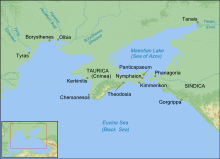
Back Historia de Crimea AN تاريخ القرم Arabic Krım tarixi Azerbaijani Ҡырым тарихы Bashkir Гісторыя Крыма Byelorussian Qırım tarihı CRH Dějiny Krymu Czech Geschichte der Krim German Ιστορία της Κριμαίας Greek Historia de Crimea Spanish


The recorded history of the Crimean Peninsula, historically known as Tauris, Taurica (Greek: Ταυρική or Ταυρικά), and the Tauric Chersonese (Greek: Χερσόνησος Ταυρική, "Tauric Peninsula"), begins around the 5th century BCE when several Greek colonies were established along its coast, the most important of which was Chersonesos near modern-day Sevastopol, with Scythians and Tauri in the hinterland to the north. The southern coast gradually consolidated into the Bosporan Kingdom which was annexed by Pontus and then became a client kingdom of Rome (63 BC – 341 AD). The south coast remained Greek in culture for almost two thousand years including under Roman successor states, the Byzantine Empire (341–1204), the Empire of Trebizond (1204–1461), and the independent Principality of Theodoro (ended 1475). In the 13th century, some Crimean port cities were controlled by the Venetians and by the Genovese, but the interior was much less stable, enduring a long series of conquests and invasions. In the medieval period, it was partially conquered by Kievan Rus' whose prince Vladimir the Great was baptised at Chersonesus Cathedral, which marked the beginning of the Christianization of Kievan Rus'. During the Mongol invasion of Europe, the north and centre of Crimea fell to the Mongol Golden Horde, and in the 1440s the Crimean Khanate formed out of the collapse of the horde but quite rapidly itself became subject to the Ottoman Empire, which also conquered the coastal areas which had kept independent of the Khanate. A major source of prosperity in these times was frequent raids into Russia for slaves for the Crimean slave trade.
In 1774, the Ottoman Empire was defeated by Catherine the Great. After two centuries of conflict, the Russian fleet had destroyed the Ottoman navy and the Russian army had inflicted heavy defeats on the Ottoman land forces. The ensuing Treaty of Küçük Kaynarca forced the Sublime Porte to recognize the Tatars of the Crimea as politically independent. Catherine the Great's incorporation of the Crimea in 1783 from the defeated Ottoman Empire into the Russian Empire increased Russia's power in the Black Sea area. The Crimea was the first Muslim territory to slip from the sultan's suzerainty. The Ottoman Empire's frontiers would gradually shrink, and Russia would proceed to push her frontier westwards to the Dniester. From 1853 to 1856, the strategic position of the peninsula in controlling the Black Sea meant that it was the site of the principal engagements of the Crimean War, where Russia lost to a French-led alliance.
During the Russian Civil War, Crimea changed hands many times and was where Wrangel's anti-Bolshevik White Army made their last stand in 1920, with tens of thousands of those who remained being murdered as part of the Red Terror. In 1921, the Crimean ASSR was created as an autonomous republic of the Russian SFSR. During World War II, Crimea was occupied by Germany until 1944. The ASSR was downgraded to an oblast within the Russian SFSR in 1945 following the ethnic cleansing of the Crimean Tatars by the Soviet regime, and in 1954, Crimea was transferred to the Ukrainian SSR as part of celebrations of the 300th anniversary of the Treaty of Pereyaslav, called the "reunification of Ukraine with Russia" in the USSR.
Following the dissolution of the Soviet Union, the Republic of Crimea was formed in 1992, although the republic was abolished in 1995, with the Autonomous Republic of Crimea established firmly under Ukrainian authority and Sevastopol being administered as a city with special status. A 1997 treaty partitioned the Soviet Black Sea Fleet, ending the protracted Black Sea Fleet dispute and allowing Russia to continue basing its Black Sea fleet in Sevastopol with the lease extended in 2010. Crimea's status is disputed. In 2014, Crimea saw intense demonstrations against the removal of the Ukrainian president Viktor Yanukovych culminating in pro-Russian forces occupying strategic points in Crimea and the Republic of Crimea declared independence from Ukraine following a disputed referendum supporting reunification. Russia then formally annexed Crimea, although most countries recognise Crimea as part of Ukraine.